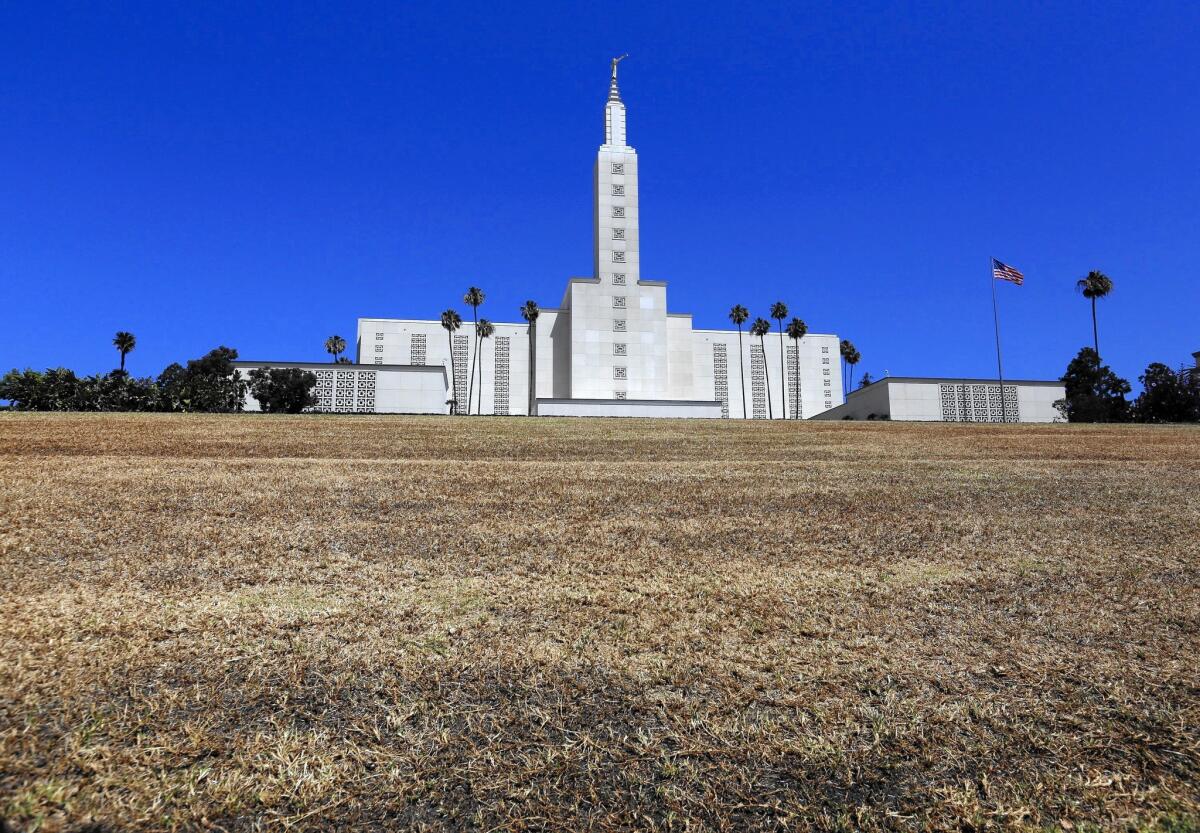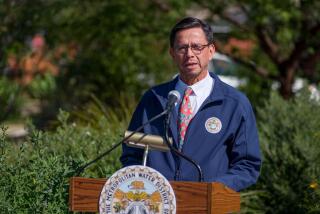Letting iconic Mormon temple lawn die was a ‘difficult decision’

The once-green grass in front of the Mormon Temple on Santa Monica Boulevard in West L.A. has become parched since the church stopped watering it about a month ago because of the drought.
- Share via
By not watering the landmark hillside lawn outside its Westwood temple, the Church of Jesus Christ of Latter-day Saints is allowing 98,000 square feet of grass to go brown because of the drought, church officials said Monday.
Church gardeners stopped watering the palatial temple’s expansive lawn last month to save water after Gov. Jerry Brown ordered cities and towns across California to cut water use by 25%, said Eric McGougan, the temple’s engineer who is responsible for the grounds. The temple hopes to cut its own water use by that amount, he said.
In recent weeks, the vast temple lawn – a landmark on Santa Monica Boulevard, has turned patchy and brown.
“It was definitely a difficult decision to let that lawn go unwatered because of what the temple represents to us,” McGougan said. “It’s a sacred place. But our intention was to join with the rest of the citizens of California and do our part to help conserve water.”
Other parts of the temple grounds remain green and lush, with flowers and gardens. Two water fountains were running Sunday afternoon, and a large reflecting pool outside the temple remained full.
But the front lawn is the biggest expanse on the property, McGougan said. Church officials, he added, are discussing long-term plans and “will be consulting with landscape architects in the future if the drought continues for a long period of time to find ways to modify our front lawn if necessary.”
“We’d love to have the rains come and that lawn come back, but we’re willing to do whatever’s necessary long-term,” he said, adding that there has been a largely positive reaction to the dead grass.
Over the years, he said, the front lawn has been invaded by kikuyu grass, an aggressive, hardy grass that does well in dry conditions and is considered by many to be a weed. McGougan said he hoped that the hardier grass would allow the lawn to green up some without additional water.
The Los Angeles temple, which sits on a 13-acre site, was the first Mormon temple built in California, dedicated in 1956. It is the second-largest Mormon temple in the world, behind the one in Salt Lake City. Temples are considered holy, and only Mormon church members are allowed to enter.
Doug Andersen, a Salt Lake City-based spokesman for the Church of Jesus Christ of Latter-day Saints, said in a statement that the church was “pleased to join others across Los Angeles and California in reducing water consumption during this historic drought.”
The Los Angeles temple, he said, has reduced its water usage over the last three years and has watered its grounds on a reduced schedule as required by the Los Angeles Department of Water and Power.
“We hope and pray that weather conditions change so we can restore the beauty of the temple grounds,” Andersen said.
The local temple’s move to reduce water consumption comes as West Los Angeles and other affluent communities have drawn scrutiny. A recent UCLA study that examined a decade of Department of Water and Power data found that on average, wealthier neighborhoods consumed three times more water than lower-income areas.
Data on individual utility customers’ water usage is not public under state law, making a more detailed analysis of the biggest users difficult.
In response to growing concerns about water usage, Beverly Hills last week approved new rules intended to help the city cut its water use by more than a third by February. Under the new requirements, residents can be fined up to $1,000 for draining and refilling swimming pools, washing cars at home with potable water or watering their lawns more than two days a week.
Stephanie Pincetl, director of the California Center for Sustainable Communities at UCLA, said the move by the Mormon Church could serve as an important signal to other water users.
“I think what it does is it provides some leadership in the sense of, they’ve taken it seriously, it’s possible to do it, and others should,” she said.
For more California news, follow @haileybranson on Twitter.
More to Read
Sign up for Essential California
The most important California stories and recommendations in your inbox every morning.
You may occasionally receive promotional content from the Los Angeles Times.














